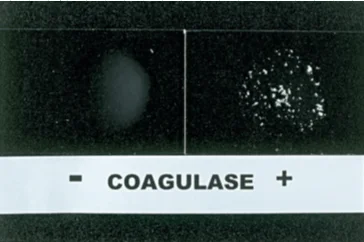Content :
Ⅰ. Overview
⚡ The coagulase test differentiates Staphylococcus aureus strains from other coagulase negative species (CoNS).
Coagulase is an enzyme-like protein that causes plasma to clot by converting fibrinogen to fibrin. Staphylococcus aureus produces two forms of coagulase:
- Free coagulase : Converts fibrinogen to fibrin, free coagulase is detected by the tube coagulase test
- Bound coagulase : Cell wall bound coagulase (i.e. clumping factor) is detected by the slide coagulase test.
⚡ For both tests, lumps or clots of any size indicate a positive response
Ⅱ. Free coagulase
The tube coagulase test is done by mixing bacterial cells into a larger volume of plasma in a small test tube.
As the bacteria multiply in plasma, they secrete staphylocoagulase which reacts with plasma globulin factor (coagulase reaction factor) to form staphylothrombin (staphylocoagulase + prothrombin).
Staphylothrombin then catalyzes the degradation of fibrinogen into insoluble fibrin which then forms the clot.
⚡ How to do the tube coagulase test :
- Label the test tube with the number of the strain to be tested.
- Using the pipette, aseptically transfer 0.5 mL of the reconstituted plasma into the test tube.
- Select two or three isolated colonies of bacteria to be tested and collect them using the sterile loop or applicator stick.
- Emulsify the bacteria in the 0.5 ml of plasma and place them in the incubator
- Note the time the test started. Observe the culture at regular intervals over the next four hours for the presence of a clot. Any clot formation is a positive result.
- If no clots are observed after 4 hours, the test can be continued with an overnight incubation at room temperature and a final observation at 24 hours.
- The positive control organism should show clotting after 24 hours, while the negative control organism would not.
Note :
- For the tube coagulase test, EDTA plasma is more reliable than citrate plasma because citrate-using organisms such as Pseudomonas species, Serratia marcescens, Enterococcus faecalis, and some strains of Streptococcus will coagulate citrated plasma.
- Certain other species of staphylococci, including Staphylococcus schleiferi and Staphylococcus intermedius, may give positive results in the tube coagulase test
- The tube coagulase test should not be unduly agitated as this may cause the clot to shrink, also giving a false negative result.
Ⅲ. Bound coagulase (clumping factor)
Bound coagulase is a protein located on the surface of the wall of Staphylococcus aureus, in an external position. It has a structure complementary to that of fibrinogen and therefore constitutes a fibrinogen receptor.
Bound coagulase can be detected by a slide agglutination test, in which a suspension of the organism is emulsified on a slide with a drop of rabbit plasma.
If bound coagulase is present, the organisms clump together (Clumping will occur because the clumping factor is an adhesin, a member of the MSCRAMM family of adhesion molecules, which causes cells to bind fibrinogen in plasma). For proper interpretation of this test, a control in which saline solution is used instead of plasma is required to verify autoagglutination.

Ⅳ. Can human plasma be used for coagulase testing ?
When using human plasma for coagulase testing, antibody production and antibiotic circulation must also be considered, as both can give false negative reactions.
Citrate can cause false positive reactions by the action of contaminating microorganisms that use citrate in plasma (such as Enterococcus faecalis can destroy the anticoagulant and cause coagulation)
EDTA is not utilized by bacteria and therefore will not give rise to false positive coagulase reactions.
When using human plasma, it is advisable to pool samples from at least 5-10 people, then distribute them in small aliquots sufficient to last 1 week and freeze the remainder until needed. This will help eliminate errors due to insufficient fibrinogen or the presence of inhibitory substances in a particular patient's sample.
Different volumes (0.5 ml, 2 ml, 5 ml) with Different dilutions (1/5, 1/6, 1/10) of plasma are proposed.
Ⅴ. Coagulase test from blood culture broth
Blood culture broth that has been incubated for 18 hours is removed and a 1:10 dilution is prepared by suspending 10 drops (0.25 ml) of blood culture broth in 2.5 ml of 0 .9%. After a brief vortexing, 4 drops (0.1 ml) are added to the 1 ml of rabbit plasma.
The tube is examined after 4 hours of aerobic incubation. Then incubated overnight at room temperature and re-examined. The test is recorded as positive if a clot is observed at either time.
